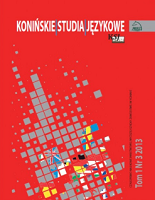Visual sign framing in nonverbal communication: Signs from Hadhrami Arabic and Polish contexts
Visual sign framing in nonverbal communication: Signs from Hadhrami Arabic and Polish contexts
Author(s): Awadh Ba-AwaidhanSubject(s): Language studies, Semiotics / Semiology, Communication studies, Semantics, Sociolinguistics
Published by: Akademia Nauk Stosowanych w Koninie
Keywords: Arabic; culture; framing; graphic sign; Hadhramout-Yemen;
Summary/Abstract: This study investigates how individuals from different cultures can perceive and comprehend visual signs-graphic symbols used as communication medium. More specifically, the fundamental objective is to illuminate the primary factors behind understanding and realization of graphic symbols and their referential meaning by students in Hadhramout-Yemen and Poland. Discussion focuses on cultural underpinnings and cognitive development, along with insights from four frameworks: semantic frames (Fillmore, 1985; Lakoff, 2004), cultural anthropology (Hofstede, 1980, Katan, 1999), prototypical theory (Rosch, 1978), and the theory of reconceptualization emergence (Lewandowska-Tomaszczyk, 2010). This framework consists of a multimodal reconceptualization involving schematization, categorization, and conventionality to determine how viewers interpret signs. Participants were presented with graphic signs, and a test was conducted on how well they understood the signs and their meaning. Results of participants’ reactions we obtained show subtle variations in the way viewers realize and perceive signs’ messages. The conclusion suggests that the cultural specificity, prototypicality, and uniqueness of the referent influence the viewers’ understanding of graphic signs and the meaning of their referents.
Journal: Konińskie Studia Językowe
- Issue Year: 9/2021
- Issue No: 2
- Page Range: 205-227
- Page Count: 23
- Language: English

